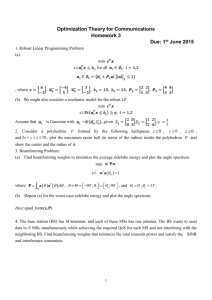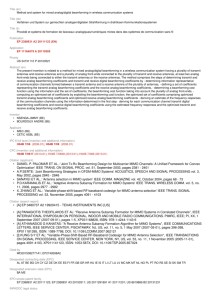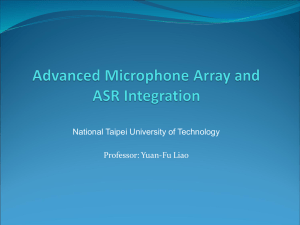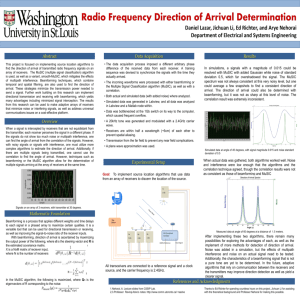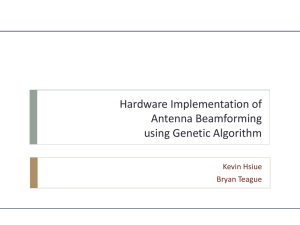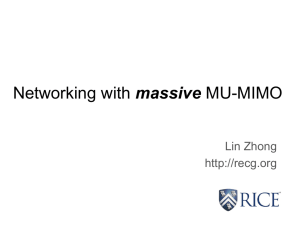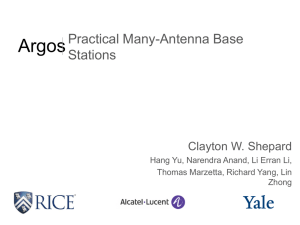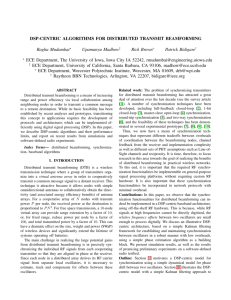Beamforming on Mobile Devices: A First Study {hang.yu, lzhong, ashu,
advertisement
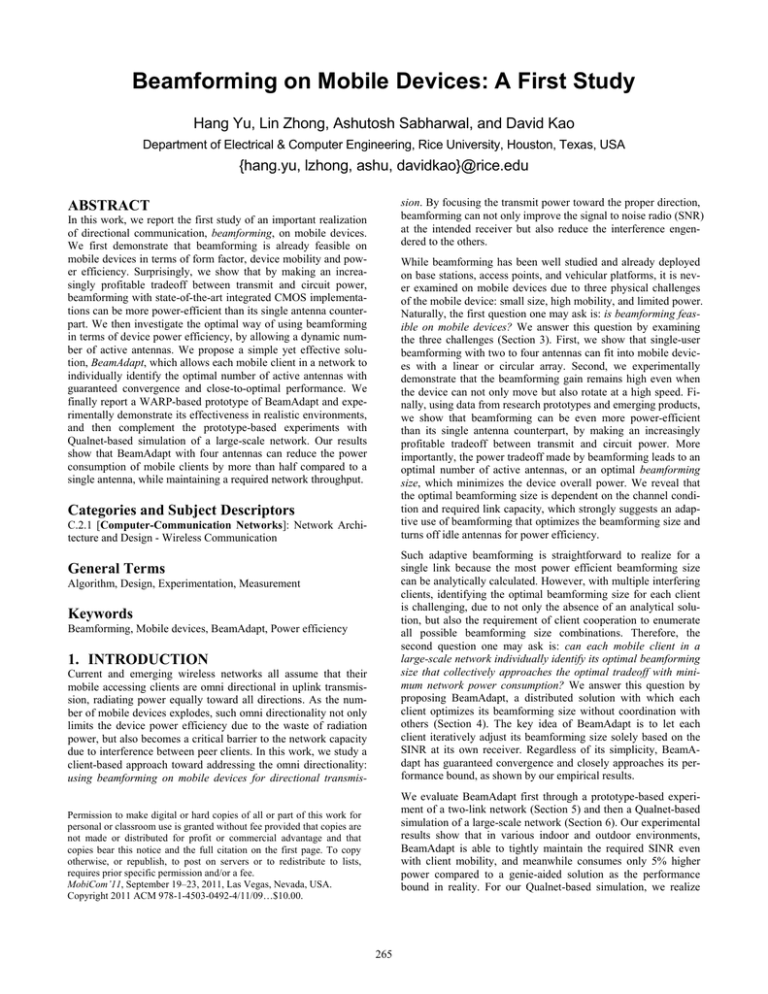
Beamforming on Mobile Devices: A First Study
Hang Yu, Lin Zhong, Ashutosh Sabharwal, and David Kao
Department of Electrical & Computer Engineering, Rice University, Houston, Texas, USA
{hang.yu, lzhong, ashu, davidkao}@rice.edu
ABSTRACT
sion. By focusing the transmit power toward the proper direction,
beamforming can not only improve the signal to noise radio (SNR)
at the intended receiver but also reduce the interference engendered to the others.
In this work, we report the first study of an important realization
of directional communication, beamforming, on mobile devices.
We first demonstrate that beamforming is already feasible on
mobile devices in terms of form factor, device mobility and power efficiency. Surprisingly, we show that by making an increasingly profitable tradeoff between transmit and circuit power,
beamforming with state-of-the-art integrated CMOS implementations can be more power-efficient than its single antenna counterpart. We then investigate the optimal way of using beamforming
in terms of device power efficiency, by allowing a dynamic number of active antennas. We propose a simple yet effective solution, BeamAdapt, which allows each mobile client in a network to
individually identify the optimal number of active antennas with
guaranteed convergence and close-to-optimal performance. We
finally report a WARP-based prototype of BeamAdapt and experimentally demonstrate its effectiveness in realistic environments,
and then complement the prototype-based experiments with
Qualnet-based simulation of a large-scale network. Our results
show that BeamAdapt with four antennas can reduce the power
consumption of mobile clients by more than half compared to a
single antenna, while maintaining a required network throughput.
While beamforming has been well studied and already deployed
on base stations, access points, and vehicular platforms, it is never examined on mobile devices due to three physical challenges
of the mobile device: small size, high mobility, and limited power.
Naturally, the first question one may ask is: is beamforming feasible on mobile devices? We answer this question by examining
the three challenges (Section 3). First, we show that single-user
beamforming with two to four antennas can fit into mobile devices with a linear or circular array. Second, we experimentally
demonstrate that the beamforming gain remains high even when
the device can not only move but also rotate at a high speed. Finally, using data from research prototypes and emerging products,
we show that beamforming can be even more power-efficient
than its single antenna counterpart, by making an increasingly
profitable tradeoff between transmit and circuit power. More
importantly, the power tradeoff made by beamforming leads to an
optimal number of active antennas, or an optimal beamforming
size, which minimizes the device overall power. We reveal that
the optimal beamforming size is dependent on the channel condition and required link capacity, which strongly suggests an adaptive use of beamforming that optimizes the beamforming size and
turns off idle antennas for power efficiency.
Categories and Subject Descriptors
C.2.1 [Computer-Communication Networks]: Network Architecture and Design - Wireless Communication
Such adaptive beamforming is straightforward to realize for a
single link because the most power efficient beamforming size
can be analytically calculated. However, with multiple interfering
clients, identifying the optimal beamforming size for each client
is challenging, due to not only the absence of an analytical solution, but also the requirement of client cooperation to enumerate
all possible beamforming size combinations. Therefore, the
second question one may ask is: can each mobile client in a
large-scale network individually identify its optimal beamforming
size that collectively approaches the optimal tradeoff with minimum network power consumption? We answer this question by
proposing BeamAdapt, a distributed solution with which each
client optimizes its beamforming size without coordination with
others (Section 4). The key idea of BeamAdapt is to let each
client iteratively adjust its beamforming size solely based on the
SINR at its own receiver. Regardless of its simplicity, BeamAdapt has guaranteed convergence and closely approaches its performance bound, as shown by our empirical results.
General Terms
Algorithm, Design, Experimentation, Measurement
Keywords
Beamforming, Mobile devices, BeamAdapt, Power efficiency
1. INTRODUCTION
Current and emerging wireless networks all assume that their
mobile accessing clients are omni directional in uplink transmission, radiating power equally toward all directions. As the number of mobile devices explodes, such omni directionality not only
limits the device power efficiency due to the waste of radiation
power, but also becomes a critical barrier to the network capacity
due to interference between peer clients. In this work, we study a
client-based approach toward addressing the omni directionality:
using beamforming on mobile devices for directional transmis-
We evaluate BeamAdapt first through a prototype-based experiment of a two-link network (Section 5) and then a Qualnet-based
simulation of a large-scale network (Section 6). Our experimental
results show that in various indoor and outdoor environments,
BeamAdapt is able to tightly maintain the required SINR even
with client mobility, and meanwhile consumes only 5% higher
power compared to a genie-aided solution as the performance
bound in reality. For our Qualnet-based simulation, we realize
Permission to make digital or hard copies of all or part of this work for
personal or classroom use is granted without fee provided that copies are
not made or distributed for profit or commercial advantage and that
copies bear this notice and the full citation on the first page. To copy
otherwise, or republish, to post on servers or to redistribute to lists,
requires prior specific permission and/or a fee.
MobiCom’11, September 19–23, 2011, Las Vegas, Nevada, USA.
Copyright 2011 ACM 978-1-4503-0492-4/11/09…$10.00.
265
0.5lambda
0.3lambda 120
0.1lambda
•
•
30
180
0
210
330
240
We report the first feasibility study of beamforming on mobile devices in terms of form factor, device mobility and
power efficiency. Our examination shows that beamforming
is not only feasible but also profitable to mobile devices.
We provide a concise solution, BeamAdapt, which allows
each client in the network to rapidly identify the optimal
beamforming size to achieve the required capacity with
close-to-maximal power efficiency. The simplicity of BeamAdapt allows its immediate realization on current mobile
devices.
We report a prototype of BeamAdapt based on the WARP
platform and a system design for realizing BeamAdapt on
the clients of cellular networks. Our prototype-based and
Qualnet-based evaluations collectively demonstrate the feasibility and power efficiency benefit of BeamAdapt.
7
60
150
In summary, we make the following technical contributions toward beamforming on mobile devices:
•
90
270
300
Peak beamforming gain (dB)
BeamAdapt in the context of modern cellular systems. We show
that by leveraging uplink power control, one can easily realize
BeamAdapt on mobile clients with trivial protocol modification.
We show that within a large-scale cellular network, BeamAdapt
with four antennas can reduce power consumption of the client
wireless transceiver by 54%, while achieving similar network
throughput.
6
4 antennas
3 antennas
2 antennas
5
4
3
2
1
0
0
0.1
0.2
0.3
0.4
Antenna spacing (wavelength)
0.5
Figure 1: (Left) Beamforming pattern of a linear array with
four antennas, under different antenna spacing; (Right) Peak
beamforming gain with different antenna spacing, for beamforming size from two to four. Both are for single-user beamforming.
rence by realizing a higher beamforming gain at the intended
receiver than that at other receivers. Apparently, the number of
active antennas, or the beamforming size, N, has a significant
impact on the beamforming gain. With appropriate antenna spacing, beamforming with N antennas can achieve a peak gain up to
N, or 10log(N) in dB [3], when signals from all transmit antennas
add coherently at the intended receiver.
2.1 Antenna Spacing
BeamAdapt can be extended in two orthogonal ways (Section 7).
First, while we propose BeamAdapt for transmit beamforming in
this work, receive beamforming on mobile clients can similarly
adopt BeamAdapt for power efficiency, with an even simpler
formulation. Second, BeamAdapt leverages the beamforming
gain to achieve client power efficiency given the capacity requirement. The beamforming gain can be alternatively used to
improve the capacity given the client power constraint, indicating
a dual formulation of BeamAdapt.
Antenna spacing is critical for form-factor constrained mobile
devices, and it directly affects the beamforming gain. In this work
we only consider single-user beamforming, where the antenna
spacing is relatively small (<0.5 λ where λ is the wavelength of
the carrier signal) so that one cannot expect a diversity gain from
the multiple antennas. As a result, the transmitter optimizes its
weight vector to maximize the SNR for a single receiver. Figure 1
(Left) shows the beamforming pattern of a four-antenna linear
array with different antenna spacing [3]. Apparently, when the
antenna spacing decreases, the beamforming pattern becomes
wider and the peak gain drops, which is also illustrated by Figure
1 (Right). We must note that Figure 1 is only about the transmit
beamforming pattern, while the SNR at the receiver is additionally affected by the channel. The transmit beamforming pattern
represents the beamforming gain relative to omni directional
transmission under the same channel.
Although there has been recent research focus to enable directionality on mobile devices using passive directional antennas, e.g.,
[1, 2], our work is the first to study the possibility of powerefficient real-time beamforming on mobile devices in a large
scale network. Beamforming, as a more flexible and more beneficial realization of directional communication, can fundamentally
removes the limitation of client omni directionality on the network capacity and client power efficiency. We hope our initial
study of beamforming on mobile devices can motivate and invite
more serious research efforts to fully realize its potential in many
other directions.
Figure 1 (Right) also shows that when the antenna spacing drops
below certain threshold, the peak beamforming gain decreases,
due to the power leakage toward a wider range of directions. The
minimum antenna spacing for achieving the largest possible peak
gain (10log(N) dB) depends on the number of antennas and is
typically 0.3-0.4 λ. Again, we do not consider antenna spacing
over 0.5 λ since it is not only difficult to realize on form-factor
constrained mobile devices but also undesirable due to its significant side lobes in single-user beamforming.
2. BEAMFORMING PRIMER
Unlike omni directional transmission with a single antenna,
beamforming uses a group of antennas to increase the SNR of the
received signal. Each antenna includes a passive antenna and a
devoted RF chain that bridges the baseband signal and RF signal.
Beamforming operates by adaptively assigning proper weights to
the baseband signal and then transmitting the weighted signals
through multiple antennas. It can be mathematically presented as:
Multi-antenna techniques other than single-user beamforming
usually have a more demanding requirement for antenna spacing.
Multi-user beamforming [4] and null beamforming require the
antenna spacing be above 0.5 λ [5], in order to exploit additional
degrees of freedom when choosing the weight vector. Spatial
multiplexing/diversity techniques, a.k.a. MIMO techniques, typically need an antenna spacing of multiple wavelengths to operate
with a satisfactory capacity improvement [5]. Apparently, they do
not fit into smartphone-like mobile devices for the frequency
bands in use today (2-5 GHz).
𝒙(𝑡) = 𝒘 ∙ 𝑠(𝑡), 𝒙(𝑡) = �𝑥1 (𝑡), ⋯ , 𝑥𝑁 (𝑡)�, 𝒘 = (𝑤1 , ⋯ , 𝑤𝑁 ),
where the baseband signal, weight vector and output signal vector
are denoted as s(t), w and x(t), respectively.
The beamforming gain, G, is defined as the ratio of the received
signal or interference power with beamforming, to that with a
single antenna. Beamforming increases SNR and reduces interfe-
266
2.2 Channel Estimation
PCircuit
To guarantee the signals from multiple transmit antennas add
coherently at the receiver to achieve the maximal beamforming
gain, beamforming requires channel knowledge at the transmitter.
In single-user beamforming, the weight vector is assigned as
𝒘 = 𝒉∗ , where h is the channel vector in which each of its elements represents the corresponding coefficient of the channel
between a transmit antenna and the receiver. The channel vector
h is often generally denoted as Channel State Information (CSI).
DAC
Baseband
Signal
Frequency
Synthesizer
Baseband
Signal
For transmit beamforming, CSI can be obtained through either
closed-loop or open-loop estimation. For closed-loop CSI estimation, the transmitter needs to send training symbols to the receiver,
and then the receiver leverages the training symbols to calculate
the channel coefficients and sends the CSI back to the transmitter.
For open-loop CSI estimation, the transmitter estimates the reverse channel when receiving and assumes it for the channel of
transmitting. Apparently, open-loop CSI estimation requires
channel reciprocity to be effective.
PShared
DAC
Filter
Filter
PA1
⋮
N
PAN
Mixer
3. FEASIBILITY STUDY
The first reaction one has toward beamforming on mobile device
is likely to be: is it feasible at all (possibly thinking of the bulky,
power-hungry Phocus Array system [9])? In this section, we examine three key physical challenges to put beamforming on mobile devices: form factor, device mobility and power efficiency.
Our key conclusion after a careful examination is: beamforming
not only is feasible for mobile devices with a reasonable size, but
also can improve their power efficiency if used properly.
3.1 Form Factor
With the advancement of semiconductor technologies, multiple
RF chains are already being integrated into a single wireless transceiver chip, e.g., [10]. Therefore, the form factor challenge introduced by beamforming only stems from its antenna spacing
requirement. As discussed in Section 2.1, beamforming typically
requires the antenna spacing to be higher than 0.3-0.4 λ, or 4.5-6
cm at 2 GHz. There is no obstacle for medium-size mobile devices such as tablets and NetBooks to embrace four antennas, in
either a linear array or a circular array. Small-size mobile devices
such as smartphones can accommodate two antennas in a linear
array or four in a circular array.
Accurately modeling the power characteristic of wireless transceivers is known to be challenging, especially with various transceiver realizations. However, since all the beamforming transmitters have similar components (Figure 2), and our power saving
solution is as simple as turning off a RF chain, very accurate
power modeling is unnecessary. Therefore, in this work we follow the widely-accepted power model proposed by [6] with improved modeling for the power amplifier. As shown by Figure 2,
the transmitter power consumption includes that of the circuitry
shared by all active RF chains, i.e., the frequency synthesizer,
denoted as PShared, and that of each active RF chain. The power
contributed by each active RF chain can be further broken down
to that by the power amplifier, and that by the rest of the chain,
denoted as PCircuit. We assume identical power amplifiers for all
the RF chains and combine their power consumption, jointly denoted as PPA with the output power from the transmit antenna
included. Clearly, PPA is dependent on the total transmit power,
PTX, while PCircuit is constant irrespective of PTX.
It is also worth noting that multi-antenna solutions using passive
directional antennas reported in [1] do not have much antenna
spacing requirement, because only one directional antenna is
active at any time. However, the solution requires all the directional antennas to be properly oriented, introducing a different
and even larger form factor challenge.
3.2 Device Mobility
We model PPA as PPA=PTX/η, where η is the efficiency of the
power amplifier. The efficiency η is usually dynamic depending
on the transmit power, and here we approximate η as a linear
function of PTX [7] but note that the power amplifier itself is not
necessarily linear. As a result, the total power of the beamforming transmitter, P, can be fairly accurately modeled as
𝑇𝑋
Filter
In the rest of the paper, we adopt parameters as follows: ηmin=0.3,
ηmax=0.5, PCircuit=48.2 mW, PShared=50 mW. They are chosen
based on [7, 8] as well as all recent CMOS wireless transceiver
designs we have collected (see Section 3.3). Those parameters are
on par with state-of-the-art transceiver designs in 2-5 GHz band
[6].
For single-user beamforming, given h, the weight vector w is also
given without the need of any additional computation. This is
different to other MIMO techniques which often need considerable signal encoding and processing even at the transmitter. As a
result, single-user beamforming incurs little power overhead to
the baseband processing and we next focus on its RF power characteristic. Figure 2 illustrates the major RF hardware components of a beamforming transmitter. The transmitter consists of
multiple RF chains, each of which is connected to a passive antenna. When we say an antenna is active, we mean that the RF
chain connected to the antenna is powered on. When an antenna
is not in use, the corresponding RF chain can be powered off to
conserve power.
𝑃
Mixer
Figure 2: RF components of a beamforming transmitter.
2.3 Power Characteristic
𝑃 = 𝜂(𝑃𝑇𝑋 ) + 𝑁𝑃𝐶𝑖𝑟𝑐𝑢𝑖𝑡 + 𝑃𝑆ℎ𝑎𝑟𝑒𝑑 .
Filter
PPA
A mobile device can not only move but also rotate. Recent work
has shown that beamforming with predefined beam patterns can
cope with vehicular mobility very well, e.g., [11, 12]. However,
real-time beamforming imposes a new challenge due to the requirement of accurate CSI, including only not the magnitude but
also the phase of the channel coefficients which are largely affected by device rotation. Therefore, next we focus on evaluating
the beamforming gain under device rotation, since rotation can
(1)
267
Outdoor
0
N=2
6
3
0
N=4
N=2
6
3
0
N=4
(a) CSI estimation per 10 ms
Outdoor
Max
Static
90d/s
180d/s
Beamforming gain (dB)
3
Indoor
Max
Static
90d/s
180d/s
Beamforming gain (dB)
6
Beamforming gain (dB)
Beamforming gain (dB)
Indoor
Max
Static
90d/s
180d/s
N=2
N=4
6
Max
Static
90d/s
180d/s
3
0
N=2
N=4
(b) CSI estimation per 100 ms
1200
SISO
2x2 MIMO
1000
800
600
400
200
0
2002
2004
2006 2008
Year
2010
Client power consumption (mW)
Transmitter Power Consumption (mW)
Figure 3: Beamforming gain under CSI estimation with various client rotation speeds. We show the results in different environments and with different CSI estimation frequencies.
1200
1000
800
N=1
N=2
N=3
N=4
Table 1: Simulation settings for the power tradeoff made by
beamforming.
Parameters
Distance
Max beamforming size
Power decay factor
Receiver noise
Channel bandwidth
Carrier frequency
600
400
200
0
6
4
2
Uplink capacity (b/s/Hz)
Figure 4: (Left) Transmitter power trend from designs in
ISSCC and JSSC; (Right) Client power consumption to
deliver a range of link capacity.
Values
0.5 km
4
4
-170 dBm/Hz
5 MHz
2 GHz
provement of RF integrated circuits is slower than that of their
digital counterparts, their power efficiency still improves significantly over years.
possibly introduce even faster channel variation than movement
can.
We perform the experiments using the WARP software radios [13]
and a concrete experimental setup is presented in the Appendix.
The key question we aim to answer is: what is the impact of device rotation on the CSI estimation and the corresponding beamforming gain? To see this, Figure 3 shows the average beamforming gain under CSI estimation with different rotation speeds of
the client node. In each sub-figure of Figure 3, four values of the
beamforming gain for each beamforming size are shown: the
upper bound given by perfect CSI (Max), the one given by estimated CSI with a stationary client (Static), the one given by estimated CSI with a rotating client at 180°/s (180d/s).
To illustrate this trend, we have examined the CMOS wireless
transceiver realizations at 2-5 GHz, reported in ISSCC [14] and
JSSC [15], the top conference and journal for semiconductor
circuits, from 2003 to 2010. In Figure 4 (Left), we show the circuit power consumption, PCircuit+PShared, of both single-antenna
(SISO) and multi-antenna (MIMO) transceivers in their transmit
mode. The figure clearly shows the continuous improvement in
the power efficiency of both SISO and MIMO transceivers. As
semiconductor process technologies continue to improve, PCircuit
and PShared will continue decreasing. Meanwhile, the power efficiency of power amplifiers is primarily limited by the transmit
power, which will not change over time. As a result, PPA will
increasingly dominate the total transmitter power consumption.
Clearly seen from Figure 3, when the CSI estimation interval is
10 ms, the CSI can be very accurate even with client rotation
speed of 180°/s. As a result, the maximal beamforming gain, i.e.,
3 dB and 6 dB with N=2 and N=4 respectively, can be closely
achieved. When the interval is increased to 100 ms, the beamforming gain will be affected by client rotation. The rotation has
higher impact for larger beamforming sizes due to a more focused
beamforming pattern. Therefore, we conclude that even under
high speed device rotation such as 180°/s, beamforming can still
be effective with reasonable CSI estimation intervals, e.g., 10 ms.
Finally, we observe that the performance of CSI estimation is
more stable indoor, due to richer multipath effect to compensate
faulty directions. This can be seen from the range of the beamforming gain in each sub-figure.
3.3.1 Power Tradeoff by Beamforming
By focusing the transmit power toward the intended direction,
beamforming can reduce the required transmit power, PTX, and
therefore the power consumption of the power amplifiers, PPA. As
a result, despite of higher circuit power consumption, beamforming is likely to improve the transceiver power efficiency. Clearly,
beamforming makes a tradeoff between transmit and circuit power: with a beamforming size of N, the transmit power can be reduced to 1/N compared to a single antenna due to the beamforming gain. Note that beamforming is able to yield a total transmit
power reduction instead of that of each antenna, i.e., the reduction
is not because of the allocation of transmit power into multiple
antennas.
3.3 Power Efficiency
Compared to omni directional transmission with a single antenna,
beamforming increases power consumption of the RF circuitry by
simultaneously using multiple active RF chains. While the im-
We next briefly analyze this tradeoff between transmit and circuit
power. For simplicity, we consider a single uplink channel from a
268
mobile client to its infrastructure node and assume line-of-sight
(LOS) propagation with the settings specified in Table 1. Figure 4
(Right) shows the client power consumption calculated by Equation (1) to deliver a range of link capacity for beamforming sizes
from one to four. One can make two important conclusions from
the figure. First, beamforming (N>1) is already more powerefficient than a single antenna (N=1) when delivering the uplink
capacity of 3.2 b/s/Hz or higher. Second, the larger the required
link capacity, the larger the most power-efficient beamforming
size. Therefore, beamforming is increasingly desirable in delivering a higher capacity, which current wireless networks are trying
to provide, in order to accommodate more mobile devices and
throughput-intensive applications.
Algorithm 1: Identify the optimal beamforming size and
transmit power for each client by BeamAdapt
Input: SINR constraint 𝜌, max beamforming size 𝑁𝑚𝑎𝑥
𝑜𝑝𝑡
Output: optimal beamforming size 𝑁 𝑜𝑝𝑡 , transmit power 𝑃𝑇𝑋
1
2
3
4
5
6
7
8
9
10
11
12
13
14
15
16
4. POWER-EFFICIENT BEAMFORMING
ON MOBILE DEVICES
The above findings suggest an adaptive way to use beamforming
on mobile devices: one shall adjust the beamforming size for the
optimal tradeoff between transmit and circuit power, according to
link capacity requirement. Next we show that to achieve the optimal tradeoff in a network is indeed non-trivial and, therefore,
provide a solution, BeamAdapt.
4.1 Key Challenges
As shown in Figure 4 (Right), the optimal beamforming size varies according to the required link capacity. Given the power
decay factor and distance, one can derive the required transmit
power for omni directional transmission, PO, to achieve certain
link capacity. Using Equation (1), we can calculate the optimal
beamforming size as
𝑁𝑜𝑝𝑡 = �𝑃𝑂 /𝐶1 𝑃𝐶𝑖𝑟𝑐𝑢𝑖𝑡 − 𝐶2 𝑃𝑂 /𝐶1
(0)
(0)
�𝑃𝑇𝑋 , 𝑁 (0) � = (𝑃𝑇𝑋 , 1), 𝑘 = 0
obtain 𝑆𝐼𝑁𝑅(0)
while �𝑆𝐼𝑁𝑅(𝑘) − 𝜌� ≥ 𝜀
𝑃𝑚𝑖𝑛 = +∞
for 𝑁 (𝑘) ≤ 𝑁 (𝑘+1) ≤ 𝑁𝑚𝑎𝑥
(𝑘+1)
compute 𝑃𝑇𝑋
(𝑘+1)
𝑃 = 𝑃𝑇𝑋 /𝜂 + 𝑁 (𝑘+1) 𝑃𝐶𝑖𝑟𝑐𝑢𝑖𝑡 + 𝑃𝑆ℎ𝑎𝑟𝑒𝑑
if 𝑃 ≤ 𝑃𝑚𝑖𝑛
(𝑘+1)
𝑜𝑝𝑡
�𝑃𝑇𝑋 , 𝑁 𝑜𝑝𝑡 � = �𝑃𝑇𝑋 , 𝑁 (𝑘+1) �
𝑃𝑚𝑖𝑛 = 𝑃
end
end
obtain 𝑆𝐼𝑁𝑅(𝑘+1)
𝑘 =𝑘+1
end
𝑜𝑝𝑡
return �𝑃𝑇𝑋 , 𝑁 𝑜𝑝𝑡 �
size, Ni, must be integers no greater than Ni,max, where Ni,max is the
number of antennas on client i.
Therefore, we formulate the optimization problem as:
minimize 𝑃𝑁𝑒𝑡𝑤𝑜𝑟𝑘 = ∑𝑀
𝑖=1 𝑃𝑖 (𝑃𝑇𝑋,𝑖 , 𝑁𝑖 )
s.t. 𝑆𝐼𝑁𝑅𝑖 (𝑷 𝑇𝑋 , 𝑵) = 𝜌𝑖 , 1 ≤ 𝑁𝑖 ≤ 𝑁𝑖,𝑚𝑎𝑥
(2)
where Pi is the power consumption of client i and
where C1 and C2 are constants determined by the power amplifier.
Again, beamforming with more antennas is increasingly more
efficient as PCircuit decreases according to the continual progress
in semiconductor technologies.
𝑷 𝑇𝑋 = �𝑃𝑇𝑋,1 , ⋯ , 𝑃𝑇𝑋,𝑀 �, 𝑵 = (𝑁1 , ⋯ , 𝑁𝑀 ).
Solving this optimization problem is very challenging. First, each
SINR constraint is a function of all 2M optimization variables.
The SINR function is non-convex with respect to these variables,
yielding the non-convexity of the problem. Second, there is no
closed-form formulation of the beamforming gain to unintended
receivers as a function of N. Its dependence on the receiver direction makes low-order approximation infeasible. Last, the integer
constraint on Ni renders a NP-hard mixed integer programming
(MIP) problem [16]. While an exhaustive searching algorithm can
ultimately offer the solution, the complexity can be as high as
𝑂�∏𝑀
𝑖=1(𝑁𝑖,𝑚𝑎𝑥 )�, which becomes prohibitive as M grows. More
importantly, such brute-force algorithm requires all the clients
have knowledge of each others’ actions in order to enumerate all
beamforming size combinations, and cooperatively choose their
beamforming sizes. Coordination between clients is known to be
hard and overhead-intensive in wireless networks.
While the optimal tradeoff given by Nopt appears straightforward
to identify with a single link (PO is uniquely decided by the required link capacity or SNR), it is challenging to determine in a
network with multiple links. This is because PO is determined by
SINR instead of SNR due to interference. Meanwhile, different
beamforming size will generate different interference toward
other receivers, implicitly affecting their own SINR. As a result,
the optimal beamforming size can no longer be calculated by
Equation (2).
Nonetheless, the tradeoff between transmit and circuit power is
still valid and there exists a most power-efficient beamforming
size for each client that collectively minimizes the aggregated
client power consumption, or network power consumption. The
immediate question we seek to answer is: how could clients of a
large network identify their most power-efficient beamforming
sizes that collectively lead to the minimum network power consumption?
To tackle this, we introduce a distributed algorithm, BeamAdapt,
with which each client simply performs individual optimization
on the beamforming size without coordination.
4.2 Problem Formulation
4.3 Distributed Algorithm: BeamAdapt
We seek to minimize the aggregated power consumption by all
the clients in a network, PNetwork, with a constraint on the capacity,
or equivalently the SINR of each link i, SINRi. We separately
constrain the SINR of each link since different links usually have
different capacity requirements. In addition, the beamforming
First we decompose the problem into multiple, individual subproblems, i.e., the ith link’s problem (i=1,2,⋯M) is formulated as
min 𝑃𝑖 s.t. 𝑆𝐼𝑁𝑅𝑖 = 𝜌𝑖 .
269
4000
2000
0
0
50
0.8
Probability (%)
6000
60
1
BeamAdapt
Bound
Omni
CDF
Network power consumption (mW)
8000
0.6
0.4
0.2
5
10
15
Simulation repetition
(a) Network power consumption comparison
30
20
10
0
0
0.5
1
1.5
2
Addtional network power consumption (%)
20
40
(b) CDF of the additional power consumption by BeamAdapt
0
2
4
6
8
Number of iterations before convergence
(c) PDF of the convergence speed of
BeamAdapt
Figure 5: Empirical results for the performance bound and convergence speed of BeamAdapt, in the seven-cell network.
The optimal (PTX,i, Ni) is determined iteratively. Let us temporally
omit the subscript i below since all clients employ the same algorithm. We assume the transmit power and beamforming size are
(𝑘)
𝑃𝑇𝑋 and N(k) in the kth iteration, and the received SINR is
(𝑘+1)
and N(k+1) are identi𝑆𝐼𝑁𝑅(𝑘) , then in the (k+1)th iteration, 𝑃𝑇𝑋
fied by solving the following optimization problem:
(𝑘+1)
min𝑃(𝑘+1) ,𝑁(𝑘+1) 𝑃𝑇𝑋
𝑇𝑋
s.t.
(𝑘+1)
𝑃𝑇𝑋
(𝑘)
𝑁 (𝑘+1)
𝑃𝑇𝑋 𝑁 (𝑘)
This problem is isomorphic to the well-studied network power
control problem where a distributed algorithm ensures convergence [17]. As a result, during each stage (𝑘𝑙 ) the power control
component either converges, or it moves onto a new stage. Since
the number of potential stages L is finite, the overall algorithm is
guaranteed to converge.
4.5 Performance Bound of BeamAdapt
/𝜂 + 𝑁 (𝑘+1) 𝑃𝐶𝑖𝑟𝑐𝑢𝑖𝑡 + 𝑃𝑆ℎ𝑎𝑟𝑒𝑑
𝜌
= 𝑆𝐼𝑁𝑅(𝑘), 𝑁
(𝑘+1)
≥𝑁
(𝑘)
We next investigate the steady-state performance of BeamAdapt.
It is possible that BeamAdapt converges to a sub-optimal solution. Unfortunately, the performance bound of BeamAdapt is not
analytically obtainable, again due to the non-convexity of the
optimization problem and the integer constraints on the beamforming size. Therefore, we have to rely on empirical methods to
study the performance bound. We employ a seven-cell network
that includes one hexagon cell and its six immediate neighbors of
identical size. Each cell has an infrastructure node in the center
that serves one client inside the cell at a time. Such seven-cell
network configuration is often used as the first-order approximation of large-scale infrastructure networks. Other settings are
similarly adopted from Table 1. To eliminate the dependency of
BeamAdapt on the client location, we repeat the simulation extensively with random client locations. Therefore, we are in fact
averaging the performance of BeamAdapt with dynamic network
configurations.
.
The initial beamforming size is set to one, i.e., 𝑁 (0) = 1, while
(0)
𝑃𝑇𝑋 can be arbitrary.
The iteration stops when �𝑆𝐼𝑁𝑅(𝑘) − 𝜌� ≤ 𝜀, where 𝜀 can be set
according to the accuracy requirement. In each iteration,
(𝑘)
(𝑃𝑇𝑋 , 𝑁 (𝑘) ) can be obtained by searching among all feasible
beamforming sizes, with the complexity of 𝑂�max(𝑁𝑖,𝑚𝑎𝑥 )� .
Algorithm 1 shows the pseudo-code of the BeamAdapt. We note
that when M=1, the problem reduces to single-link optimization
which offers the same solution as Equation (2) does.
4.4 Convergence of BeamAdapt
The iteration process of BeamAdapt is guaranteed to converge.
Next we provide a brief yet sufficiently illustrative proof. The
two key facts we leverage are: (i) whenever the beamforming
sizes are fixed, the iteration of BeamAdapt is isomorphic to a
distributed power control algorithm that ensures convergence; (ii)
the change of the beamforming size N of each client is monotonous. That is, the beamforming size can only increase during the
iteration.
Figure 5 (a) shows a few samples of the network power consumption of BeamAdapt, and its upper bound given by the theoretically optimal solution using a brute-force algorithm with client cooperation. The figure also shows the performance of omni directional transmission for comparison. Clearly, the performance of
BeamAdapt is very close to the optimal and much better than that
of omni. Figure 5 (b) shows the CDF of the additional network
power consumption by BeamAdapt compared to its bound: BeamAdapt indeed converges to the optimal solution with a probability of 55%, and only incurs 0.5% additional power compared to
the optimal solution when it converges to a sub-optimal.
Therefore, we divide the iteration process into multiple stages,
𝑘𝑙 (1 ≤ 𝑙 ≤ 𝐿), where during each stage N is constant and only
PTX changes. The current stage 𝑘𝑙 evolves into 𝑘𝑙+1 when N
changes for any one link. Based on the monotonicity of N we
have the following inequality
Using the same network configuration, we can also evaluate the
convergence speed of BeamAdapt. Figure 5 (c) shows the PDF of
the number of iterations to achieve a small 𝜀, i.e., 0.1% in our
simulation. Clearly, BeamAdapt often converges rapidly, i.e.,
with typically less than three iterations to get a stable SINR.
𝐿 ≤ ∏𝑀
𝑖=1(𝑁𝑖,𝑚𝑎𝑥 ) < +∞,
which indicates a finite number (L) of stages.
During each stage, the beamforming size is fixed; therefore the
original problem turns in to
min 𝑃𝑁𝑒𝑡𝑤𝑜𝑟𝑘 = ∑ 𝑃𝑖 (𝑃𝑇𝑋,𝑖 ), s. t. 𝑆𝐼𝑁𝑅𝑖 (𝑷 𝑇𝑋 ) = 𝜌𝑖 .
270
Infrastructure Node 1
Infrastructure Node 2
Ethernet Router
Uplink
(Wireless)
Uplink
(Wireless)
Client Node 1
Client Node 2
Laptop with MATLAB
Figure 6: WARPLab setup for the experimental evaluation of
BeamAdapt.
Client (Indoor)
Client (Outdoor)
Infrastructure (Indoor)
Infrastructure (Outdoor)
5m
Figure 7: Environment layout and node locations for the
experimental evaluation of BeamAdapt.
5. PROTOTYPE-BASED EVALUATION
5.2 Experiment Setup
In Section 3 we showed that a close-to-maximal beamforming
gain can be achieved even when the mobile client rotates at
180°/s. However, compared to static beamforming with a fixed
number of active antennas, BeamAdapt faces a new challenge due
to its iterative nature: are mobile clients with BeamAdapt able to
timely identify the right number of antennas and transmit power
in real-time so that the required SINR is achieved with nearmaximal power reduction? To answer the question, we use
WARP to experimentally evaluate the effectiveness of BeamAdapt in realistic environments.
We test the prototype under two physical environments: one inside a building and the other on an empty lawn, both in a university campus. The former and the latter represent typical indoor
and outdoor environments, respectively. We use four WARP
nodes, including two client nodes and two infrastructure nodes, to
form a two-link network. Figure 6 shows our WARPLab setup
and Figure 7 shows the locations of the client and infrastructure
nodes in the experiment.
While in realistic wireless networks there might be more links
that interfere with each other, we consider this two-link network
as a reasonable setup for experiments. First, the two-link network
is a widely used model in wireless network researches [5], due to
its simplicity and generality. Second, even though in realistic
such as cellular networks there are more than two base stations
within the coverage of a mobile client, the client is often mainly
interfering with only one additional base station. This is due to
the distributed fashion of placing base stations in a certain area
and that each client often connects to the closest base station. Last,
since we have selected the ISM bands and the environments of
our experiments have continuous but unpredictable wireless
transmissions, there are indeed other interference sources at the
infrastructure nodes.
BeamAdapt is compatible with any infrastructure-based network
architecture. Since we are not able to conduct experiments on
cellular bands due to the lack of license, we instead use ISM band
(2.4 GHz) to verify the feasibility of BeamAdapt. Our Qualnetbased evaluation in Section 6 will complementarily show the
power saving and network throughput performance of BeamAdapt within a large-scale cellular network.
5.1 BeamAdapt Prototype
We realize BeamAdapt using WARPLab, a framework that facilitates rapid prototyping of physical layer designs and algorithms.
WARPLab allows symbol-level access to the wireless transceivers embedded on the WARP board, which we leverage to realize
the key functionalities of BeamAdapt including beamforming,
transmit power and beamforming size adaptation, and SINR measurement. In WARPLab, all WARP nodes are connected through
an Ethernet router and a laptop with a MATLAB interface is used
to control the nodes, implement the algorithm and collect the
measurements. Although our WARP-based prototype does not
truly have a power profile for mobile devices, it is our belief that
our results will provide the first motivation for wireless modem
chipset vendors to seriously consider beamforming for mobile
devices.
In our experiments, we manually add both movement and rotation
to the two client nodes. The rotation speed is 0-120°/s, consistent
with [1]. The movement is about 0-1 meter per second. Due to the
limitation of WARPLab that the WARP boards have to be connected by Ethernet cables, we can only add pedestrian movement
speed in the experiment but will simulate a much higher speed in
the Qualnet simulation in Section 6.
5.3 Findings from Experiments
According to the problem formulation in Section 4, we examine
the effectiveness of BeamAdapt in realistic environments with
two key metrics, received SINR at the infrastructure node and
power consumption by the client node. For received SINR, we
examine whether BeamAdapt can closely approach the required
SINR even with iteration and client mobility. For power consumption, we compare the power consumption of BeamAdapt
with a genie-aided solution which can always correctly pick the
right beamforming size and transmit power without iteration.
Clearly, the genie-aided solution is always optimal and achieving
maximal power reduction. To realize the comparison, we recorded the traces of the channel coefficients during all our measure-
We have built two types of WARP nodes: one with four antennas
implementing BeamAdapt as the client node and the other with a
single antenna as the infrastructure node. The physical wireless
channel is assumed to be the uplink channel while an Ethernet
cable is used to emulate the downlink channel. Since we are only
interested in client uplink transmission, we generate dummy
frames only at the client node and continuously send them to the
infrastructure node.
271
5
I/S
I/M
O/S
O/M
0
SINR (dB)
10
0
-10
0
10
2
0
Client Node 1
20
I/S
I/M
O/S
O/M
Figure 8: Received SINR at the infrastructure node in the
experiments.
10
5
Time (s)
4
3
2
1
0
5
Time (s)
10
Client Node 2
20
10
0
-10
0
Beamforming size
4
Client Node 1
Client Node 2
4
5
Time (s)
10
5
Time (s)
10
3
2
1
0
Figure 9: Received SINR and beamforming size in the experiments at a glance.
Power consumption (mW)
ments and replayed the channel offline to emulate the genie-aided
solution.
5.3.1 Received SINR
We first report the received SINR at the infrastructure nodes. To
maximally leverage the range of WARP nodes without losing
generality, we assume moderate SINR, e.g., 5 dB and 8 dB as the
constraint. Figure 8 shows the mean and variance of the received
SINR at the two infrastructure nodes, in four scenarios: indoor/static (I/S), indoor/mobile (I/M), outdoor/static (O/S), and
outdoor/mobile (O/M).
2000
1500
5dB
BeamAdapt
Genie-aided
Power consumption (mW)
6
SINR (dB)
8dB
15
Beamforming size
SINR (dB)
8
5dB
Client Node 1
Client Node 2
SINR (dB)
10
1000
500
0
I/S
I/M
O/S
O/M
2000
1500
8dB
BeamAdapt
Genie-aided
1000
500
0
I/S
I/M
O/S
O/M
Figure 10: Power consumption of the client nodes for BeamAdapt and genie-aided solution in the experiments.
There are two key observations from the figure. First, BeamAdapt
on average can closely approach the required SINR, i.e., 5 dB and
8 dB respectively, for both stationary and mobile client nodes. In
most of the scenarios the standard variance is below 3 dB, indicating that the BeamAdapt iteration does not render significant
SINR deviation from the target value. Second, in the outdoor/mobile scenario, BeamAdapt yields much higher variance of
the received SINR. This is consistent with our observation to the
beamforming gain in Section 3.2, due to the lack of compensation
by multipath effect to the out-of-date channel estimation and
beamforming size.
fore its power consumption is not optimized and not comparable
with realistic beamforming transceivers on mobile devices.
Therefore, we use the authentic transmit power but emulate the
circuit power to achieve a rational estimation.
Figure 10 shows the average power consumption of BeamAdapt
and the genie-aided solution. Clearly, in all scenarios BeamAdapt
closely approaches the theoretically minimum power consumption given by the genie-aided solution, yielding only 5% higher
power on average. We note that the genie-aided solution has removed all the imperfections of BeamAdapt in reality, such as
converging to a sub-optimal solution, process of iteration, and
drop of beamforming gain due to mobility. Therefore, it is the
strict upper bound of the power saving performance of BeamAdapt. Not surprisingly, the additional power consumption in our
experiments is larger than that in our empirical results in Section
4.5, due to the consideration of all realistic imperfections of BeamAdapt listed above.
Figure 9 shows a ten-second snapshot of the received SINR as
well as the beamforming size of two client nodes. Clearly, most
of the time BeamAdapt is able to timely cope with channel variation and achieve a stable SINR, while the beamforming size is
indeed being adapted. We have chosen the measurements in the
indoor/mobile scenario to show in the figure while the other scenarios exhibit similar characteristics, as demonstrated by Figure 8.
While BeamAdapt on average achieves the required SINR, it does
not guarantee that the SINR is above the target value. This is due
to the formulation of BeamAdapt that seeks to use the minimum
power to achieve certain capacity. Nonetheless, BeamAdapt will
not lead to a large outage probability, since one can simply leave
a SINR margin and set the required SINR in BeamAdapt a bit
higher than the intended value. For example, if a SINR of 5 dB is
needed, one can set 8 dB as the constraint and BeamAdapt will
maintain the SINR above the threshold with a probability of 87%
according to our measurements.
6. QUALNET-BASED EVALUATION
To complement the prototype-based evaluation, we next use simulation to evaluate BeamAdapt in a large-scale network. To
achieve a close-to-reality evaluation, we adopt current cellular
protocols and introduce a system design of BeamAdapt that is
readily realizable with trivial protocol modification. We employ
the simulation tool Qualnet [18] for its open-source feature and
support of modern cellular protocols.
5.3.2 Power Consumption
6.1 Cellular-based System Design
We next compare the power consumption of BeamAdapt with
that of the genie-aided solution. Again, we note that given the
transmit power and beamforming size, the power consumption is
calculated using the power model in Section 2.3 instead of measurements. This is because the WARP node uses FPGA boards
and programmable RF boards to enable customization, and there-
We realize BeamAdapt on mobile clients in a cellular network
and again focus on uplink transmission. Due to its distributed
nature, BeamAdapt relieves clients in the network from interclient coordination thereby entails minor protocol modification.
There are two key questions one need to answer regarding the
system design of BeamAdapt. First, how does BeamAdapt per-
272
400
200
0
N=1
N=2
N=4
N=8
1
0.5
0
N=1
N=2
N=4
N=8
(a) FTP traffic
1000
800
2
Beamforming/Omni
BeamAdapt
Network Throughput (b/s)
600
1.5
6
x 10
Beamforming/Omni
BeamAdapt
Client Power Consumption (mW)
800
2
Beamforming/Omni
BeamAdapt
Network Throughput (b/s)
Client Power Consumption (mW)
1000
600
400
200
0
N=1
N=2
N=4
N=8
1.5
5
x 10
Beamforming/Omni
BeamAdapt
1
0.5
0
N=1
N=2
N=4
N=8
(b) CBR traffic
Figure 11: Client power consumption and network throughput comparison between BeamAdapt, static beamforming and omni
directional transmission.
form uplink CSI estimation? Second, how does BeamAdapt obtain
the received SINR to perform the beamforming size adaptation?
We next provide the answers.
We assume the UMTS network system in Qualnet and use the
same seven-cell network configuration shown in Section 4.5.
However, here we add more clients, i.e., thirty, to mimic realistic
base station scheduling and handoff in cellular networks. The area
is 4 km×4 km and the base stations have fixed locations, 1.5 km
from its neighbors. While the range of each base station is approximately 1 km, we let their coverage overlap similar to realistic cellular networks in urban areas. The clients are allowed to
have random linear movement with speed from zero to seventy
miles per hour, corresponding to a wide range of client movement
speed such as stationary, pedestrian and vehicular. We also incorporate horizontal rotation to the client, with an upper bounded
rotation speed of 120°/s, consistent with [1]. We add two applications to the client: FTP with an unlimited-size file to transfer and
constant-bit-rate (CBR) with multiple relatively small packets.
FTP generates continuous traffic. CBR, on the contrary, creates
intermittent traffic by the idle intervals between small-size packets. The FTP traffic has a higher capacity requirement than the
CBR traffic.
6.1.1 Uplink CSI Estimation
Due to the absence of uplink/downlink channel reciprocity in
cellular networks [19], we can only adopt closed-loop CSI estimation (see Section 2.2) in BeamAdapt. That is, the client concatenates a short field made up of several training symbols to the
data field in each uplink frame. Seeing the training symbols, the
base station estimates uplink CSI and sends it back to the client.
Thanks to the full-duplex property of cellular channels, the estimated CSI can be simultaneously delivered to the client through
downlink control signaling while the client is involved in uplink
transmission. Therefore, CSI feedback does not incur any additional uplink channel occupation. Moreover, the training field can
be very short compared to the entire frame length, i.e., a 16 μs
training field for beamforming size of four and a 10 ms frame in
UMTS/LTE [19], which further trivialize the overhead of CSI
estimation. According to our measurement in Section 3.2, the 10
ms frame length in UMTS/LTE guarantees accurate CSI estimation of BeamAdapt, even with client rotation.
We evaluate the power reduction benefit of BeamAdapt by comparing it with omni directional transmission and static beamforming with a fixed beamforming size. We examine BeamAdapt and
static beamforming with two, four and eight antennas. Note that
BeamAdapt with N=4 means that the client can select from one to
four active antennas (with unused antennas powered off) while
static beamforming with N=4 always uses four active antennas.
6.1.2 Beam Adaptation
To adapt the beamforming size and transmit power, BeamAdapt
needs to know the received SINR of each frame. While it can be
similarly sent back to the client through downlink control signaling, we seek to minimize the protocol modification, by leveraging
the uplink power control mechanism included in cellular protocols. Uplink power control is widely used in cellular networks to
maintain a constant SINR of each client at its base station. It is
initiated by the base station, through sending a power control
command to the client, containing the value of the required
transmit power. Noticeably, this required transmit power is actually PO in Equation (2), and one can directly identify the optimal transmit power PTX and beamforming size N using PO, as one
iteration in the BeamAdapt algorithm. This way, the received
SINR is no longer needed by the client and no protocol change is
required.
6.3 Findings from Simulation
Figure 11 shows the average power consumption of the client as
well as the network throughput, under omni, static beamforming
and BeamAdapt. We make several key observations. First, BeamAdapt saves more power for the FTP traffic than the CBR traffic since FTP averagely requires higher transmit power. For example, compared to omni directional transmission BeamAdapt
with N=4 saves 54% and 50% client power for the FTP and CBR
traffic, respectively. Second, BeamAdapt with four antennas already provides sufficient power efficiency benefit. The power
reduction of BeamAdapt with N=8 is only marginally better than
that of BeamAdapt with N=4. This is due to the confined range of
cellular radio signals by the transmit power limitation from
clients. Last, the network throughput achieved by BeamAdapt is
only slightly lower (<5%) than that by omni directional transmission, and is as good as that by their respective static beamforming
counterparts. The slight degradation from omni is due to client
mobility and thereby the drop of the beamforming gain, similar to
what we observed in Section 3.2.
6.2 Simulation Setup
Since the beamforming hardware is not included in Qualnet, we
have to virtually realize a beamforming system on the client by
generating dynamic beamforming patterns in real-time and adopting the power model in Section 2.3 to calculate client power consumption.
273
Client power reduction (%)
80
70
60
50
40
30
20
10
0
80
TX power reduction only
Int reduction only
Client power reduction (%)
We also note that the power reduction by BeamAdapt stems from
two benefits of beamforming: the reduction of transmit power
from the beamforming gain, and the reduction of interference
from the directional pattern. Qualnet simulation allows us to further examine the power saving contribution from these two benefits. That is, we first keep the transmit power reduction capability
of BeamAdapt only by assuming an omni directional pattern, and
then the interference reduction capability only by assuming a
beamforming gain of zero. Figure 12 shows their respective contributions to client power reduction, with different distances from
the client to the base station. Clearly, as the client moves to cell
boundary, i.e., with a larger distance to the base station, both
capabilities of BeamAdapt can save more power, and they collectively achieve a higher overall power reduction of the client. This
is because when the client is approaching cell boundary, only not
the required transmit power increases, but also the interference
between adjacent cells is more severe.
70
TX power reduction only
Int reduction only
60
50
40
30
20
10
0.15
0.3
0.45
0.6
0.75
Distance between client and BS (km)
0
(a) FTP traffic
0.15
0.3
0.45
0.6
0.75
Distance between client and BS (km)
(b) CBR traffic
Figure 12: Breakdown of client power reduction by BeamAdapt.
8.1 Beamforming
No existing work on beamforming has considered and optimized
its use in terms of power efficiency for mobile devices such as
tablets and smartphones. Recent work such as [11, 12] considered
using beamforming on vehicles to enhance the uplink connection
as the client moves. The authors of [20] have experimentally
shown the effectiveness of switched beam systems in indoor environments. However, all above solutions use the Phocus Array
system [9] and none supports real-time beamforming. More importantly, these solutions do not consider dynamic number of
active antennas in beamforming and its power efficiency benefit
as we do. Early results from our work on power-efficient beamforming on mobile devices were reported in [21].
7. DISCUSSION
We next discuss two important ways to extend BeamAdapt.
7.1 BeamAdapt for Receive Beamforming
While we concentrate on transmit beamforming in this work,
BeamAdapt can be straightforwardly extended to receive beamforming at the mobile client for downlink performance enhancement. Similarly, we allow a dynamic number of antennas in the
beamforming receiver and again the maximal receive beamforming gain is equal to the receive beamforming size. The problem
formulation of BeamAdapt in Section 4 still holds only with the
client power consumption, P, being replaced by
8.2 Directional Antennas on Mobile Devices
Passive directional antenna is a simple yet inflexible solution to
realize directional communication on mobile devices. Many have
studied them for infrastructure nodes and mobile nodes that do
not rotate, e.g., see [22-29]. Most of the authors focus on MAC
protocol designs. In contrast, BeamAdapt is in the physical layer
and is complementary to directional MAC designs. Only very
recently, the authors of [1, 2] demonstrated the effectiveness of
passive directional antennas in improving throughput and power
efficiency of mobile devices that can rotate. The solution is based
on selecting one out of multiple fixed passive directional antennas. However, there is a key limitation toward their solution: only
a limited number of passive antennas are allowed to be implemented, e.g., four in [1], and they are hard to be properly oriented.
Such limitation renders a confined gain of their solution due to
the failure to cover all directions, i.e., only 3 dB gain using 5 dBi
and 8 dBi antennas. In contrast, beamforming with BeamAdapt
can easily track channel variation and achieves a guaranteed gain
of 6 dB using four antennas.
𝑃 = 𝑁𝑃𝐶𝑖𝑟𝑐𝑢𝑖𝑡 + 𝑃𝑆ℎ𝑎𝑟𝑒𝑑 .
Because the transmit power is no longer involved, solving the
problem is in fact trivial by letting each client use just enough
antennas to meet the SINR requirement. Moreover, downlink CSI
estimation is even simpler for the client, since the client can directly measure the SINR. As a result, receive BeamAdapt can be
easily realized without any modification to the cellular protocol.
7.2 Dual Formulation of BeamAdapt
Our problem formulation in Section 4.2 attempts to minimize the
network power consumption to achieve certain network capacity.
A dual problem to maximize network capacity can be formulated
as follows:
maximize 𝐶𝑁𝑒𝑡𝑤𝑜𝑟𝑘 = ∑𝑀
𝑖=1 𝐶𝑖 (𝑷 𝑇𝑋 , 𝑵)
s.t. 𝑃𝑖 (𝑃𝑇𝑋,𝑖 , 𝑁𝑖 ) = 𝜌𝑖 ′ , 1 ≤ 𝑁𝑖 ≤ 𝑁𝑖,𝑚𝑎𝑥 .
Unlike traditional work that leverages beamforming for maximizing network capacity under a client power constraint, this dual
formulation also considers circuit power. As a result, the power
tradeoff is still valid and BeamAdapt can be properly modified to
provide a distributed solution to this dual problem.
8.3 Energy-Efficient MIMO
While in this work we consider beamforming for its adaptive use
in a power-efficient manner, similar concept can be extended to
MIMO systems. In [30], we provided a system design of an adaptive MIMO system and experimentally shown that it can minimize the energy per bit of the MIMO transceiver by properly
choosing the number of active RF chains. The idea is also explored by the authors of [31] and [32]. The authors of [33] have
analytically showed the effectiveness and performance of such
adaptive MIMO systems. These solutions, however, are limited to
a single link, while BeamAdapt is solving a network problem by
optimizing the use of beamforming on multiple mobile clients.
8. RELATED WORK
While multi-antenna techniques and directional communication
have been generally studied in many other regimes, our work is
the first that aims to enable power-efficient real-time beamforming on mobile devices. We next discuss related work in three
directions.
274
9. CONCLUSION
[11] V. Navda, A. P. Subramanian, K. Dhanasekaran, A. TimmGiel, and S. Das, "MobiSteer: using steerable beam directional antenna for vehicular network access," in Proc. ACM
Int. Conf. Mobile Systems, Applications and Services (MobiSys), 2007.
In this work, we reported the first study of beamforming on mobile devices. With both experiments and data from industry, we
showed that beamforming is not only feasible but also powerefficient to mobile devices. We then addressed the challenge of
identifying the optimal use of beamforming on mobile device, by
formulating an optimization problem and providing the BeamAdapt solution. Through both experiments and simulation, we
showed that BeamAdapt is able to react to client mobility by
promptly identifying the right beamforming size and the transmit
power. Collectively it achieves more than 50% power reduction
of the clients in a large-scale network.
[12] K. Ramachandran, R. Kokku, K. Sundaresan, M. Gruteser,
and S. Rangarajan, "R2D2: regulating beam shape and rate
as directionality meets diversity," in Proc. ACM Int. Conf.
Mobile Systems, Applications and Services (MobiSys),
2009.
[13] WARP, http://warp.rice.edu/, 2011.
[14] IEEE International Solid State Circuits Conference.
Client directionality through beamforming is a radical departure
from omni directionality assumed by current mobile network
paradigms. While we are able to demonstrate its benefit in client
power efficiency, more research efforts at various layers of the
network system is intended to fully appreciate its potential, which
we leave to future work.
[15] IEEE Journal of Solid-State Circuits.
[16] G. L. Nemhauser and L. A. Wolsey, Integer and combinatorial optimization: Wiley-Interscience, 1988.
[17] R. D. Yates, "A framework for uplink power control in
cellular radio systems," IEEE Journal on Selected Areas in
Communications, 1995.
ACKNOWLEDGEMENT
[18] Scalable Network Technologies, QualNet Developer: Highfidelity network evaluation software.
This work was supported in part by NSF awards ECCS/IHCS
0925942, CNS/NeTS-WN 0721894, CNS/CRI 0751173, CNS0551692, and support from the TI Leadership University program.
The authors would like to thank the anonymous reviewers for
their useful suggestions.
[19] E. Dahlman, S. Parkvall, J. Skold, and P. Beming, 3G Evolution: HSPA and LTE for Mobile Broadband: Academic
Press, 2008.
[20] M. Blanco, R. Kokku, K. Ramachandran, S. Rangarajan,
and K. Sundaresan, "On the Effectiveness of Switched
Beam Antennas in Indoor Environments," in Proc. Passive
and Active Network Measurement (PAM), 2008.
REFERENCE
[1]
A. Amiri Sani, L. Zhong, and A. Sabharwal, "Directional
antenna diversity for mobile devices: characterizations and
solutions," in Proc. ACM Int. Conf. Mobile Computing and
Networking (MobiCom), 2010.
[2]
A. Amiri Sani, H. Dumanli, L. Zhong, and A. Sabharwal,
"Power-efficient directional wireless communication on
small form-factor mobile devices," in Proc. ACM/IEEE Int.
Sym. Low Power Electronics and Design (ISLPED), 2010.
[3]
L. C. Godara, Smart Antennas: CRC Press, 2004.
[4]
E. Aryafar, N. Anand, T. Salonidis, and E. W. Knightly,
"Design and experimental evaluation of multi-user beamforming in wireless LANs," in Proc. ACM Int. Conf. Mobile
Computing and Networking (MobiCom), 2010.
[5]
D. Tse and P. Viswanath, Fundmentals of Wireless Communication: Cambridge University Press, 2005.
[6]
Z. Li, W. Ni, J. Ma, M. Li, D. Ma, D. Zhao, J. Mehta, D.
Hartman, X. Wang, K. K. O, and K. Chen, "A Dual-Band
CMOS Transceiver for 3G TD-SCDMA," in IEEE Int. Solid-State Circuits Conference (ISSCC), 2007.
[7]
T. H. Lee, "The Design of CMOS Radio-Frequency Integrated Circuits," Cambridge University Press, 2004.
[8]
S. Cui, A. J. Goldsmith, and A. Bahai, "Energy-efficiency
of MIMO and cooperative MIMO techniques in sensor networks," IEEE Journal on Selected Areas in Communications, 2004.
[9]
[21] H. Yu, L. Zhong, and A. Sabharwal, Beamsteering on mobile devices: network capacity and client efficiency: Technical Report 0623-2010, Rice University, 2010.
[22] S. Yi, Y. Pei, and S. Kalyanaraman, "On the capacity improvement of ad hoc wireless networks using directional antennas," in Proc. ACM Int. Sym. Mobile Ad Hoc Networking
and Computing (MobiHoc), 2003.
[23] L. Bao and J. J. Garcia-Luna-Aceves, "Transmission scheduling in ad hoc networks with directional antennas," in
Proc. ACM Int. Conf. Mobile Computing and Networking
(MobiCom), 2002.
[24] Y. Ko, V. Shankarkumar, and N. H. Vaidya, "Medium
access control protocols using directional antennas in ad
hoc networks," in Proc. IEEE INFOCOM, 2000.
[25] T. Korakis, G. Jakllari, and L. Tassiulas, "A MAC protocol
for full exploitation of directional antennas in ad-hoc wireless networks," in Proc. ACM Int. Sym. Mobile Ad Hoc
Networking & Computing (MobiHoc), 2003.
[26] R. R. Choudhury, X. Yang, R. Ramanathan, and N. H.
Vaidya, "Using directional antennas for medium access
control in ad hoc networks," in Proc. ACM Int. Conf. Mobile Computing and Networking (MobiCom), 2002.
[27] M. Takai, J. Martin, A. Ren, and R. Bagrodia, "Directional
virtual carrier sensing for directional antennas in mobile ad
hoc networks," in Proc. ACM Int. Sym. Mobile Ad Hoc
Networking and Computing (MobiHoc), 2002.
Fidelity Comtech, Data Sheet: Phocus Array 3110X 2008.
[10] D. G. Rahn, M. S. Cavin, F. F. Dai, N. H. W. Fong, R. Griffith, J. Macedo, A. D. Moore, J. W. M. Rogers, and M.
Toner, "A fully integrated multiband MIMO WLAN transceiver RFIC," IEEE Journal of Solid-State Circuits (JSSC),
2005.
[28] X. Liu, A. Sheth, M. Kaminsky, K. Papagiannaki, S. Seshan, and P. Steenkiste, "DIRC: increasing indoor wireless
capacity using directional antennas," in Proc. ACM SIGCOMM, 2009.
275
Appendix: WARP Setup for CSI Estimation
[29] X. Liu, A. Sheth, M. Kaminsky, K. Papagiannaki, S. Seshan, and P. Steenkiste, "Pushing the envelope of indoor
wireless spatial reuse using directional access points and
clients," in Proc. ACM Int. Conf. Mobile Computing and
Networking (MobiCom), 2010.
We build a circular array with four antennas on one WARP board
as the client node, and use a single antenna on the other WARP
board as the infrastructure node. The antenna spacing in the circular array is 0.5 λ. The client and infrastructure nodes are placed
close to the allowed range of WARP board with a moderate SNR
(5 dB), i.e., 10 meters in our experiments. The client node continuously sends training symbols to the infrastructure node every
10 ms and the latter sends back the estimated CSI through an
Ethernet cable. Therefore, the mobile client updates the CSI every
10 ms, calculates the weight vector and then performs beamforming. To challenge the CSI estimation, we rotate the client node
with a computerized motor at 90°/s and 180°/s respectively, while
realistic mobile devices rotate at a much slower speed, e.g., 10°/s
as the median and 120°/s as the upper bound [1]. We repeat the
experiments both indoor and outdoor. While we could not simultaneously examine different beamforming sizes and different CSI
estimation frequencies in real time, we have collected traces of
the channel coefficients and emulated the channel offline. That is,
we replay the channel using the recorded traces but assume different beamforming sizes (2 and 4), and different CSI estimation
frequencies (10 ms and 100 ms). Since the beamforming gain is
only dependent on the CSI, the offline emulation gives identical
results as real-time evaluation does.
[30] H. Yu, L. Zhong, and A. Sabharwal, "Adaptive RF chain
management for energy-efficient spatial-multiplexing MIMO transmission," in Proc. ACM/IEEE Int. Sym. Low Power Electronics and Design (ISLPED), 2009.
[31] I. Pefkianakis, S.-B. Lee, and S. Lu, MIPS: MIMO Power
Save in 802.11n Wireless Networks: UCLA Computer
Science Department Technical Report TR-100040-2010.
[32] D. Halperin, B. Greensteiny, A. Shethy, and D. Wetherall,
"Demystifying 802.11n power consumption," in Proc.
USENIX Int. Conf. Power Aware Computing and Systems
(HotPower), 2010.
[33] H. Kim, C.-B. Chae, G. D. Veciana, and R. W. Heath, "A
cross-layer approach to energy efficiency for adaptive MIMO systems exploiting spare capacity," IEEE Trans. Wireless Communications, 2009.
276

